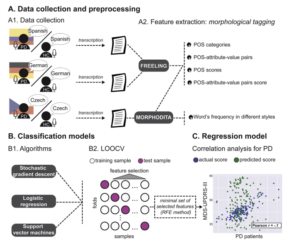From discourse to pathology: Automatic identification of Parkinson’s disease patients via morphological measures across three languages
Cortex
Eyigoz, E., Courson, M., Sedeño, L., Rogg, K., Orozco-Arroyave, J. R., Nöth, E., Skodda, S., Trujillo, N., Rodríguez, M., Rusz, J., Muñoz, E., Cardona, J. F., Herrera, E., Hesse, E., Ibáñez, A., Cecchi, G. & García, A. M. (2020). From discourse to pathology: Automatic identification of Parkinson’s disease patients via morphological measures across three languages. Cortex 132, 191-205. Online: https://bit.ly/36dMH8P.
En este trabajo combinamos análisis automatizado del lenguaje con aprendizaje de máquinas para detectar posibles marcadores discursivos de la enfermedad de Parkinson (EP). Convocamos a 330 pacientes y controles hablantes de tres lenguas tipológicamente distintas (español, alemán y checo) y les solicitamos que describieran un día típico de sus vidas. Nuestro abordaje, centrado en la caracterización de patrones morfológicos (la estructura de las palabras), permitió discriminar entre pacientes y controles con más del 80% de precisión y predecir la severidad del cuadro en los primeros. Estos hallazgos sientan las bases para evaluaciones ecológicas, no invasivas y con validez transcultural en esta y otras enfermedades neurodegenerativas.
Para acceder al artículo hacé click AQUÍ
From discourse to pathology: Automatic identification of Parkinson’s disease patients via morphological measures across three languages
Cortex
Eyigoz, E., Courson, M., Sedeño, L., Rogg, K., Orozco-Arroyave, J. R., Nöth, E., Skodda, S., Trujillo, N., Rodríguez, M., Rusz, J., Muñoz, E., Cardona, J. F., Herrera, E., Hesse, E., Ibáñez, A., Cecchi, G. & García, A. M. (2020). From discourse to pathology: Automatic identification of Parkinson’s disease patients via morphological measures across three languages. Cortex 132, 191-205. Online: https://bit.ly/36dMH8P.
Embodied cognition research on Parkinson’s disease (PD) points to disruptions of frontostriatal language functions as sensitive targets for clinical assessment. However, no existing approach has been tested for crosslinguistic validity, let alone by combining naturalistic tasks with machine-learning tools. To address these issues, we conducted the first classifier-based examination of morphological processing (a core frontostriatal function) in spontaneous monologues from PD patients across three typologically different languages. The study comprised 330 participants, encompassing speakers of Spanish (61 patients, 57 matched controls), German (88 patients, 88 matched controls), and Czech (20 patients, 16 matched controls). All subjects described the activities they perform during a regular day, and their monologues were automatically coded via morphological tagging, a computerized method that labels each word with a part-of-speech tag (e.g., noun, verb) and specific morphological tags (e.g., person, gender, number, tense). The ensuing data were subjected to machine-learning analyses to assess whether differential morphological patterns could classify between patients and controls and reflect the former’s degree of motor impairment. Results showed robust classification rates, with over 80% of patients being discriminated from controls in each language separately. Moreover, the most discriminative morphological features were associated with the patients’ motor compromise (as indicated by Pearson r correlations between predicted and collected motor impairment scores that ranged from moderate to moderate-to-strong across languages). Taken together, our results suggest that morphological patterning, an embodied frontostriatal domain, may be distinctively affected in PD across languages and even under ecological testing conditions.
To access the full paper please click here



